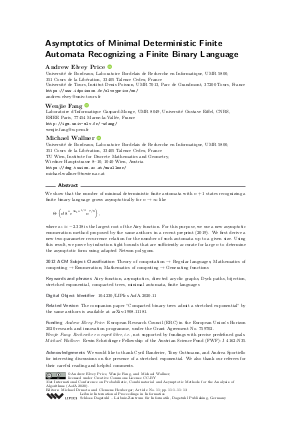@InProceedings{elveyprice_et_al:LIPIcs.AofA.2020.11,
author = {Elvey Price, Andrew and Fang, Wenjie and Wallner, Michael},
title = {{Asymptotics of Minimal Deterministic Finite Automata Recognizing a Finite Binary Language}},
booktitle = {31st International Conference on Probabilistic, Combinatorial and Asymptotic Methods for the Analysis of Algorithms (AofA 2020)},
pages = {11:1--11:13},
series = {Leibniz International Proceedings in Informatics (LIPIcs)},
ISBN = {978-3-95977-147-4},
ISSN = {1868-8969},
year = {2020},
volume = {159},
editor = {Drmota, Michael and Heuberger, Clemens},
publisher = {Schloss Dagstuhl -- Leibniz-Zentrum f{\"u}r Informatik},
address = {Dagstuhl, Germany},
URL = {https://drops-dev.dagstuhl.de/entities/document/10.4230/LIPIcs.AofA.2020.11},
URN = {urn:nbn:de:0030-drops-120419},
doi = {10.4230/LIPIcs.AofA.2020.11},
annote = {Keywords: Airy function, asymptotics, directed acyclic graphs, Dyck paths, bijection, stretched exponential, compacted trees, minimal automata, finite languages}
}

 Creative Commons Attribution 3.0 Unported license
Creative Commons Attribution 3.0 Unported license



